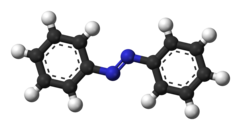
Back آزوبنزن AZB Азабензол Byelorussian Azobenzen Czech Azobenzol German Azobenceno Spanish Azobentzeno Basque آزوبنزن Persian Atsobentseeni Finnish Azobenzène French Azobenzene Italian

| |

| |
| Names | |
|---|---|
| IUPAC name
(E)-Diphenyldiazene
| |
| Other names
Azobenzene
| |
| Identifiers | |
3D model (JSmol)
|
|
| 742610 | |
| ChEBI | |
| ChEMBL | |
| ChemSpider | |
| ECHA InfoCard | 100.002.820 |
| EC Number |
|
| 83610 | |
| KEGG | |
PubChem CID
|
|
| RTECS number |
|
| UNII | |
CompTox Dashboard (EPA)
|
|
| |
| |
| Properties | |
| C12H10N2 | |
| Molar mass | 182.226 g·mol−1 |
| Appearance | orange-red crystals[1] |
| Density | 1.203 g/cm3[1] |
| Melting point | 67.88 °C (trans), 71.6 °C (cis)[1] |
| Boiling point | 300 °C (572 °F; 573 K)[1] |
| 6.4 mg/L (25 °C) | |
| Acidity (pKa) | -2.95[2] |
| -106.8·10−6 cm3/mol[3] | |
Refractive index (nD)
|
1.6266 (589 nm, 78 °C)[1] |
| Structure | |
| sp2 at N | |
| 0 D (trans isomer) | |
| Hazards | |
| Occupational safety and health (OHS/OSH): | |
Main hazards
|
toxic |
| GHS labelling: | |
  
| |
| Danger | |
| H302, H332, H341, H350, H373, H410 | |
| P201, P202, P260, P261, P264, P270, P271, P273, P281, P301+P312, P304+P312, P304+P340, P308+P313, P312, P314, P330, P391, P405, P501 | |
| Flash point | 476 °C (889 °F; 749 K) |
| Related compounds | |
Related compounds
|
Nitrosobenzene aniline |
Except where otherwise noted, data are given for materials in their standard state (at 25 °C [77 °F], 100 kPa).
| |
Azobenzene is a photoswitchable chemical compound composed of two phenyl rings linked by a N=N double bond. It is the simplest example of an aryl azo compound. The term 'azobenzene' or simply 'azo' is often used to refer to a wide class of similar compounds. These azo compounds are considered as derivatives of diazene (diimide),[4] and are sometimes referred to as 'diazenes'. The diazenes absorb light strongly and are common dyes.[5] Different classes of azo dyes exist, most notably the ones substituted with heteroaryl rings.[6]
- ^ a b c d e Haynes, p. 3.32
- ^ Hoefnagel, M. A.; Van Veen, A.; Wepster, B. M. (1969). "Protonation of azo-compounds. Part II: The structure of the conjugate acid of trans-azobenzene". Recl. Trav. Chim. Pays-Bas. 88 (5): 562–572. doi:10.1002/recl.19690880507.
- ^ Haynes, p. 3.579
- ^ IUPAC, Compendium of Chemical Terminology, 2nd ed. (the "Gold Book") (1997). Online corrected version: (2009) "azo compounds". doi:10.1351/goldbook.A00560
- ^ Saul Patai, ed. (1975). Hydrazo, Azo and Azoxy Groups. PATAI'S Chemistry of Functional Groups. Vol. 1. John Wiley & Sons. doi:10.1002/0470023414. ISBN 9780470023419.
- ^ Crespi, Stefano; Simeth, Nadja A.; König, Burkhard (March 2019). "Heteroaryl azo dyes as molecular photoswitches". Nature Reviews Chemistry. 3 (3): 133–146. doi:10.1038/s41570-019-0074-6. ISSN 2397-3358.
© MMXXIII Rich X Search. We shall prevail. All rights reserved. Rich X Search